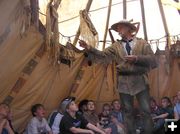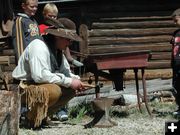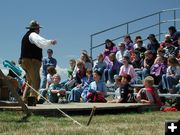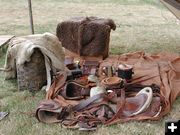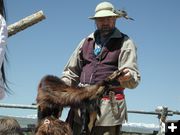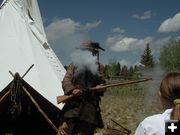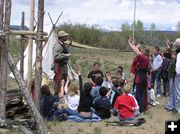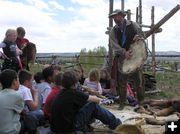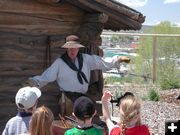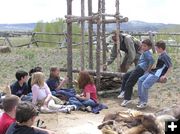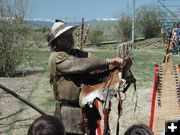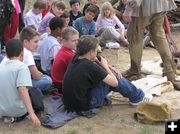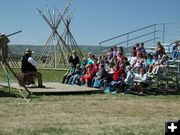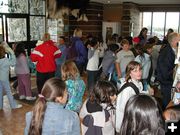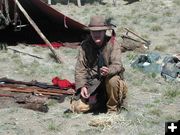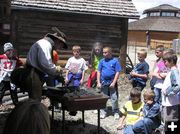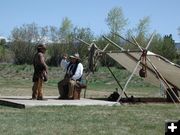
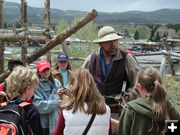
'Ol Jim' Hardee
|

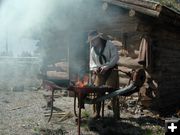
Blacksmith Alan Hall
|

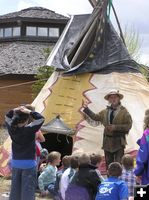
Roy 'Crazy Cyot' Hanson
|

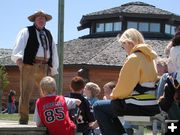
Bill Keith
|

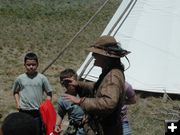
Richard Ashburn
|

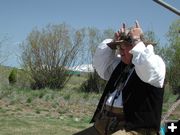
Tatonka (buffalo) sign
|

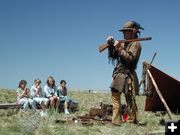
Loading a musket
|
|
Living History Days
May 21, 2004
Living History Days is an annual program held each May at the Museum of the Mountain Man in Pinedale. This year's program was held May 18-20th and was sponsored by Museum of the Mountain Man, BOCES and the American Mountain Men. Over 500 elementary school children and adults from Teton, Lincoln and Sublette counties, and LaBarge attended this year's educational program. The public was also invited and encouraged to attend the sessions.
The American Mountain Men organization was formed in 1973 by a group of mountain man enthusiasts who wanted to learn the life of mountain men by living it. They all have regular jobs, but live and learn the mountain man ways as a hobby. All told, there are approximately 600 members throughout the United States. They have one large rendezvous each year. They rest of the year they camp in small groups whenever they get a chance to experience for themselves what life was really like for the mountain men of the early 1800s. They camp during all seasons of the year, and in all weather conditions, using only the authentic supplies of the 1820-1840 mountain man. A major part of their mission is education. Towards that important goal, they participate in many 'kiddy rendezvous', such as the Living History Days at the Museum on the Mountain Man, that are somewhat scaled down to capture the attention span of children and spark their interest in the lifestyle of the people of that day through living history and visual demonstrations.
Alan Hall, a policeman from Idaho Falls, Idaho, demonstrated blacksmith techniques during Living History Days at the Museum last week. Metal was very important to mountain men, who needed it for guns, knives, traps, trade goods, etc. The most important metal object was their gun, which they needed to kill food to eat and for protection. Generally, mountain men would go a fort for blacksmith services. Metal was heated in a forge and then hammered into shape. "Jim Bridger was a blacksmith" Mr. Hall explained to children from Mrs. McLaughlin's Pinedale 4th grade class as he worked the forge and explained what he was doing. It was apparent that the class had already spent a lot of time studying about mountain men and the tools of the time as children's hands eagerly shot in the air every time Mr. Hall asked a question.
Richard Ashburn, another member of the American Mountain Men, is an outfitter based out of Jackson Hole, Wyoming. He demonstrated guns, making fire, camp and trade goods of the mountain man. The surprise sound from the black powder gun fire startled every group and was a favorite of the kids. No real ammunition is fired during these public demonstrations and safety at all times is an important part of conducting these demonstrations. The time-consuming process of loading and methodically packing the gun to get it ready to fire was a great opportunity to impress on the audience how inadequate this gun style was sometimes for the mountain men of the 1800s, such as when an angry grizzly bear might be charging right at themů
Mountain Man Bill Keith, from Utah, is retired from the Forest Service. He has been a member of the AMM since the very start, 31 years. He demonstrated Indian sign language and told mountain man stories. The favorite story with the school kids last week was the grizzly bear story.
Roy Hanson, Crazy Cyot, described the Indian teepee and discussed its significance to both the Indians and mountain man. "The mountain men learned very quickly that a teepee is a lot warmer than a log cabin" explained Crazy Cyot. "That's why they wanted to go live with the Indians during the winter if they could." There were several teepees set up at the Museum, one completely furnished and several with just the standing poles. Before going into the teepee, Crazy Cyot asked students what the difference was between a log cabin and a teepee? He explained that log cabins used fireplaces for heat, which resulted in just the spot right in front of the fire being warm with the rest of the cabin being still very cold. "Most of the heat just goes up the chimney" he told kids. In a teepee, the fire is in the middle and every part of the living space stays warm from the fire. "In a teepee, you are living IN the chimney!" he told, kids who laughed at the idea. Crazy Cyot is always a big hit for his tall tales that the kids can't seem to ever get enough of!
'Ol Jim' Hardee, (that's Ol, not Old, he told the kids), explained beaver trapping and the tools of the trapping trade. He demonstrated setting traps, let the students smell beaver castor oil, and had samples of the different kinds of animal skins the mountain man obtained. He had winter and summer pelts to show the difference between the fur thickness and why the winter fur was more desirable. He explained that these were hardy men who trapped beaver even in the coldest winter months to get the animals when the fur was the thickest, which meant more money for the trapper. This was a business, just like people work today, with a breed of men who were independent, work alone for months at a time, and self-sufficient for their own needs when they got injured or in trouble. He showed the classes the rounds of skinned beaver pelts that would be one of many in a typical mountain man's camp, if he was a good trapper. These pelts would be stretched on a willow branch bent into a circle to form a plew. The trapper would scrape off the fat and meat and leave the pelt rounds to dry at his camp. Ol' Jim also demonstrated the wood beaver press which was used to bundle furs into bales for transport to rendezvous where the mountain man received payment for his year-long trapping endeavors.
Photos and story by Clint Gilchrist and Dawn Svalberg
|







